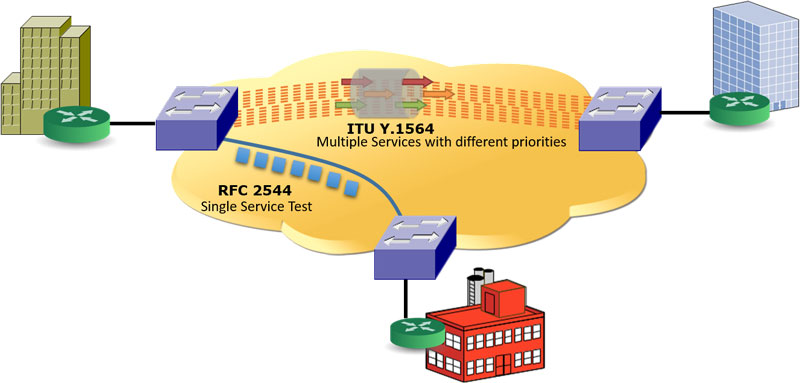

To support this process, network devices are equipped with buffering capacity. To further ensure reliability, TCP uses buffers in the devices involved at the send and receive ends of a connection, with acknowledgment of the transmitted information. TCP is a connection-oriented protocol and reliability is achieved by detecting lost segments and retransmitting them.
#RFC 2544 ETHERNET TESTING HOW TO#
It is defined by the equation above.Īnother important challenge is how to ensure that the TCP communication provides a reliable data transfer service and works in an efficient manner. TCP throughput is an important metric in measuring the quality of network connection. This challenge can be addressed with TCP throughput testing to the criteria specified in the RFC 6349 specification, which provides a framework for measuring end-to-end TCP throughput the network. These issues mean that network providers are beginning to realise that Layer 2/3 testing is no longer sufficient to adequately ensure the satisfaction of end-users. This may be caused by a non-optimal configuration of the Transmission Control Protocol (TCP) providing higher layer connections through the network. To verify network performance based on these criteria, network operators normally carry out testing based on the IETF RFC 2544 test suite: “Benchmarking methodology for network interconnect devices”.Įven if the network meets the criteria laid down in this standard, customers may still find that the throughput they achieve is below the service level specified in the agreement they have with the operator.

Generally, the network issues that are mentioned in Service Level Agreements are based on Layer 2/3 criteria such as bandwidth, latency, packet loss, and delay variations (jitter).

Of these concerns, network issues are the most significant, because all the others are relatively easy to troubleshoot and correcting these faults does not usually take very long. Some of the reasons include hardware failure, incorrect service configuration or usage, and network issues. There can be many reasons for service to users or between applications not working. The reason why these tests are important – and the most important challenge that network operators have to face - is how to meet the Service Level Agreements (SLAs) that they have with their end customers. The traditional way for network engineers to troubleshoot performance problems involves tracing the appropriate portion of the network segment and analysing the TCP/IP header data from the captured trace, which helps in understanding the condition of the network at the time of the problem.įigure 3 - The MT1100A and MT1000A eliminate end-user factors from the test process by emulating the TCP host. This analysis includes examinations of TCP flows, packet sizes, window behaviour, flow and congestion controls, and data link operations. The network is, of course, a crucial factor for any communication system, and this article will therefore focus on the technical TCP/IP challenges encountered in communication between the two end hosts in the network.Įffective analysis of the TCP/IP environment requires an understanding of the fundamental physics of network behaviour, the control mechanisms determining TCP/IP performance, and the identification of performance problems by network behaviour analysis. Some basic TCP/IP properties that form the basis of a communication system are:įigure 2 - MT1100A Network Master Flex & MT1000A Network Master Pro. TCP/IP prepares data received from applications for transmission and provides all the logical mechanisms needed to send and receive data between two devices connected via a physical network. A packet contains all the information a network needs to deliver it to its destination and then to acknowledge delivery. Segments of data are then wrapped in a data structure known as a packet. These are known as segments, and the process of splitting files is known as segmentation. TCP/IP accepts files consisting of data of any size from applications and breaks them up into smaller, more manageable pieces. In fact, TCP/IP can be said to be the de facto standard communications protocol for all connected residential users, enterprises and organisations. TCP/IP still remains the most popular communication protocol suite that defines the rules of communication between end hosts, and is the most commonly used for data transfer in the Internet. (Click here to view article in digital issue) Communication networks have evolved greatly in recent years to the extent that all-IP wired and wireless hybrid networks are now a reality. Figure 1 - TCP/IP processing data files of any size to deliver to its destination and then to acknowledge delivery.


 0 kommentar(er)
0 kommentar(er)
